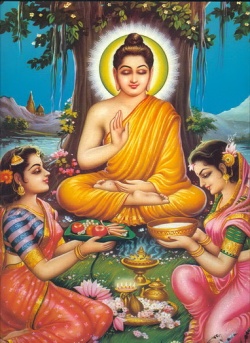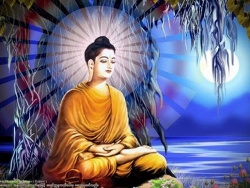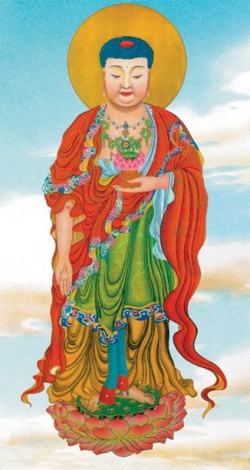Early Buddhism in Afghanistan
Buddhism has played very important role in shaping the history and culture of Afghanistan. It continued to be a Buddhist country for more that twelve centuries till the advent of Islam there in about 9th century A.D. and consequently the pristine culture and religion of Afghanistan were completely wiped out from there. The ancient monuments that we find today in Afghanistan fully attest this fact. Ancient Buddhist stupas, monasteries, caves and colossal images of the Buddha and other antiquities are found
scattered throughout the length and breadth of Afghanistan. If one travels from Jelalabad in the east and goes to Balkh in the north-west or Kunduz in the north-east or to Kandhar in the south-west, the Buddhist stupas on the plains and caves on the hills, looking like honey combs can be seen throughout the journey. The two colossal images of Buddha hewn out of the Bamiyan hillock, one being 55 meters and the other
35 meter in height are world famous. The rock cut caves with frescoes of Bamiyan are well-known . Jelalabad and Hadda are famous for the Buddhist stupas. The monastery of Ghazni (Tapa-e-Sardar) and Fondukistan are renowned for the stucco figures of the Buddha and other deities. In Kapisa, now known as Begram (Viharagrama) which was once one of the capitals of Kaniska, we find ruins of two large Buddhist
monasteries near it, one at Shotorak (=Sihaviraka) and the other at Sevaki. Afghanistan being a part of Asokan empire, we find as many as five epigraphs of this great Buddhist emperor. The famous Indo-Greek Buddhist king Menanander
(Pali = Milinda) also ruled over this country. We have found one epigraph bearing his name at Jelalabad. Very likely some of the stupas there and also near it at Hadda are the monuments constructed by this Buddhist king. During the later periods till the 8th or 11th Century AD. Buddhism flourished there and people followed this great religion.
When Buddhism became rooted in this great land is not yet finally settled. Generally it is believed that it was during the reign of Asoka when the Saddharma arrived there through the Buddhist missionaries that were deputed at the end of the Third Buddhist Council at Pataliputta
some 230 years after the Mahaparinibbana of the Buddha. No doubt Buddhism got an unprecedented impetus from the religious zeal of Asoka and so spread in many countries outside India, yet it remains unsettled as to whether it was the first introduction of Buddhism in Afghanistan at that time. Our attempt is to investigate this point first.
We know the story of Tapassu and Bhallika that come across in the early Pali and Buddhist Sanskrit texts is almost identical. They are said to have been touring merchants (Satthavaha) and met the Buddha under the Rajayatana tree at Bodha-Gaya while coming from Ukkala in the eighth week after his Enlightenment. They offered him Madhugolaka or sweet ball which the Buddha accepted. After that they took refuge in two Jewels (ratna) the Buddha and the Dhamma (not Sangha as it was yet to be founded) and thus became the first lay-devotees or Upasakas of the
Buddha. In the Anguttaranikaya Atthakatha 1.207, it is mentioned that the Buddha gave them eight handfuls of his hair which they took to their town, Asiatanjana and built stupas there. Again in the Theragatha Atthakatha it is related that they again visited the Buddha at Rajagaha where Tapassu and Bhallika were touring merchants (Satthavahas) of north or north-west of Indian sub-continent and had met the
Buddha. And if the accounts of Huen-Tsangbe given any credence, it appears plausible that their homeland was located somewhere near Balkh, the ancient Bahlika at the far end of the nor-western Afghanistan. It has also been suggested that the name Bhalluka is a derivative from the town Bahalika. Dr Lokesh Chandra on the basis of the Vibhanga Attakatha has pointed out that bhallika is a kind of copper enumerated under the
eight kinds of Pisaca-lohani, or the metals found in the Pisaca country, a land in the north-western India. Again Kamsa country got the name because bronze or copper was available there and Asitanjana was the capital of that country. He has also pointed that Bhallika got the name from the town Bahalika.
In all probability it appears that Tapassu and Bhallika were the merchants from Balkh area and they were the first persons who took the message of the Buddha to Afghanistan even during the life-time of the Lord, although not as missionaries. And thus, Balkh appears to be first region where the teachings of the Buddha arrived.
It is known from many sources that north-western region of Indian sub-continent was known to the people of eastern India. During the time of the Buddha Texila was a renowned centre for learning of many sciences. We know the story of Jivaka Komarabhacca, the celebrated physician of Magadha who got his training in medical science at this place. Many princes and nobles were also there learning
different sciences when Jivaka was studying there. The area across the Khyber Pass, which was called Uddyana or Udyana in ancient days and is now the easternmost part of Afghanistan in the Province of Ningarahar with its capital Jelalabad, was a part of Gandhara province in ancient times. It is mentioned by Huen Tsang that a Sakyan prince migrated to Uddyana after the extermination of Vidudhabha. Later this Sakyan prince became the king of this country. He had a son Uttarasena by name, who could obtain the relics of
the Buddha soon after the Mahaparinibbana of the Buddha and built a stupa over it. This stupa was seen by Huen Tsang. Sir Auerel Sien has identified it with a stupa at Shankardar in the Swat Valley, which was once a part of Uddyana. Huen Tsang also mentioned that he was greeted by the king of Bamiyan who is supposed to have belonged to the Sakyan race. The story of the Sakyan migration from eastern India, although known from late sources, appears to be a fact. And if their migration to Udyana, as they migrated elsewhere, be taken to be true, the
message of the Buddha reached the eastern part of Afghanistan even during the life-time of the Buddha. We have found the skull relics of the Buddha from Hadda and his tooth relics from Dauranta. Both these places are near Jelalabad. Fai-hien and Sung Yun also witnessed the skull relics of the Buddha and worshipped them. Another relic casket with inscription was found at Wardak located in this very area. All these antiquities discovered from this area lead us to infer that Jelalabad or Uddyana was an important centre of Buddhism from the very beginning.
In the second Buddhist council which was held at Vesali one hundred years after the mahaparinibbana of the Buddha is also significant in this context. It is said that a section of the early Theravada Sangha branched off on this occasion. They are known as Mahasanghikas, probably because they were in large number. They migrated from Magadha into two streams. One went to south India and the other to north India and
settled in Udyana. There they were again divided into five groups viz Ekavyvaharika, Kaukulika or Kurullaka, Bahusrutiya, Pranjaptivadin and Lokuttaravadin. In the Chinese translation of Sariputraparipricchasutra, the Lokuttaravadins are said to have resided at Uddyana with the Sarvastivadins the Mabisasakas, Dharmaguptas and Kasyapiyas.
Again, we find in the Pali texts that Thera Sambhuta Sanavasi, an old monk who had received his Upasampada under Ananda Thera, played an important role in the Second Buddhist Council. There we also find him coming from Ahogangapabbata for joining the Council’s deliberations. His main place of residence was Mathura. He also moved to Kipin where he stayed for sometime. Kipin has been identified with Kapisa, modern Begram in Afghanistan. Why Sambhuta Sanavasi moved to Kipin from Mathura is now known. When he reached Kipin, he
was held in great esteem. Huen Tsang witnessed his hemp or Sana robe in nine parts dyed in red, enshrined in a monastery near Bamiyan. Sambhuta Sanavasi was the supporter of early Theravada views and opposed the Hahasanghikas as we find at the time of Second Buddhist Council. It,therefore, appears probable that when the Mahasanghikas had established their stronghold at Uddyana, Sambhuta Sanavasi also decided to
move to that area and settled at Kipin. We also know from Huen Tsang’s account that Lokuttaravadins were a predominant section of Buddhist Sangha at Bamiya. It is very likely that Sambhuta Sanavasi might have visited Bamiyan from kipin in order to establish the early Therevada Buddhism in opposition to the Lokuttaravadins who had their stronghold there. It may be mentioned here that Bamiyan is not very far from Kapisa or Kipin.
The above discussions lead us to infer that in all probability Buddhism reached Afghanistan at a very early time of its foundation. It reached there soon after the Second Buddhist Council, if not earlier; ie hundred years after the Mahaparinibbana of the Buddha. The Mahasanghikas established their centre at Uddyana and Lokuttaravadins at Bamiyana and probably Sambhuta Sanavasi was able to establish some centres of early Theravada at Kipin and at Bamiyan.
The Third Buddhist Council which took place during the reign of Asoka (269-232 BC) at Pataliputta is an important event in the history of Buddhism. We know that at the end of this Council missionaries were sent to distant parts of the country and also outside. The account relates that Hajjhima Thera Maharakkhita went to Yona country. Kasmira and Gandhara are in the north and north-west of India while Yona country is the interior part of Afghanistan where the Yonas or Greeks had been settled by Alexander the Great. Gandhara also was
included in the eastern part of Afghanistan, the present area of Jelalabad, the ancient Uddyana. It is remarkable to note that in this area two missionaries were sent at the end of the Third Buddhist Council instead of one as in other parts of the country. We know, the Third Buddhist Council was convened to thrash out the ‘wrong views’ opposed to the Vibhajjavada. We have seen earlier that the Mahasanghikas and
the Lokuttaravadins had already established their centres, one at Uddyana and the other at Bamiyan in Afghanistan, Asoka himself was a strong supporter of the early Theravada school and the missionaries sent during his reign belonged to this group. Finding that the other groups had their strongholds in Afghanistan, it was probably felt expedient to dispatch two missionaries to this area instead of one, one to Gandhara, the eastern Afghanistan and the other to Yona, the interior of this country.
Buddhism was already established in Afghanistan prior to Asoka is again supported by another account of the Third Buddhist Council. One Thera Yonaka Dhammarakkhita was made in-charge of disseminating Buddhism in Aparantaka (Konkan). By his name it is evident that he hailed from Yona country. We have mentioned earlier that Yona country was the interior part of Greek settlement in Afghanistan. The
selection of Yonaka Dhammarakkhita as the leader of a mission is significant. Obviously he was a very able and efficient monk to propagate Buddhism. He was well-versed in Pali Tipitaka. We are told that he recited the Aggikhandhopama Sutta ( a sutta from Anguttaranikaya), in which the Buddha has stressed the pure life of a monk. The same Sutta was delivered by Mahinda when he went to Sri Lanka for the
same purpose. The great achievement of Yonaka Dhammaarakkhita in the scriptures and his other high attainments and achievements as a monk required some training and learning. It appears plausible to believe that probably he had his initial training in Buddhism in his own motherland ie in Afghanistan and later when he came to India, he got further training in the Religion. This proves that Buddhism was already
established in Afghanistan where Maharakkhita got his first initiation before Asoka’s reign. It was of course revitalized by Asoka in order to establish the early Theravada Buddhism.
Afghanistan remained mainly a Theravadin country for centuries. During the reign of Kaniska the Sarvastivada sect became predominant as we know the kind Kusana was the patron of this branch of Theravada. In later centuries the other branches of Theravada like Lokuttaravadins, Mahasanghikas, Kasyapiyas Mahisasakas had their centres at different places in Afghanistan, at least up to 7th century AD. When Huen
Tsang visited Bamiya, he found the Lokuttaravadins predominant there and no Mahayana Sangha was then existing there. In eastern Afghanistan in Uddyana he found only some monasteries belonging to Mahayana. In Bamiyan probably there was some centre of early Theravada Buddhism also in the Foladi valley near the village now called Arangaran. Probably this village got its name from the term Arhantanam.
Probably this was also the place where Sambhuta Sanavasi, who is said to be a Arhant, established the centre of early Theravada school of Buddhism. It was only in the 8th or 9th century AD when the Mahayana Buddhism could take its root there. We find a cave in Kakrak valley near Bamiyan in which a huge image of the Buddha has been hewn out of the rock and thereon the walls frescoes are found. Here Vairocana Buddha is painted in a Mandala, which is supposed to be the earliest example of this kind so widely popular in Tibetan form of Buddhism. A
who visited Bamiyan in 727 AD mentions that there the monks practice the Great and Little Vehicles. The king is Iranian but he and his chiefs and the people are very devoted to the Three Jewels (Buddhism). This account of the Korean monk
is the only report which clearly informs us of the existence of the Mahayana school of Buddhism in Bamiyan. At other places too Hinayana and Mahayana both flourished side by side. Throughout the history of Buddhism in Afghanistan, the Theravada Buddhism appears to have been predominant in early centuries and it is only in later period that Mahayana could become more popular.



